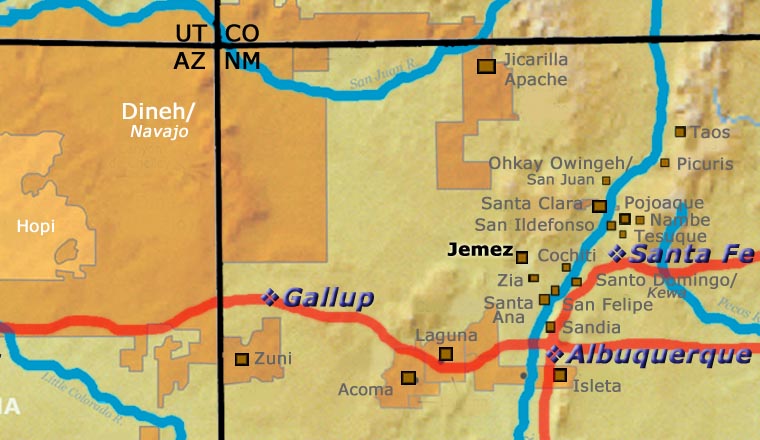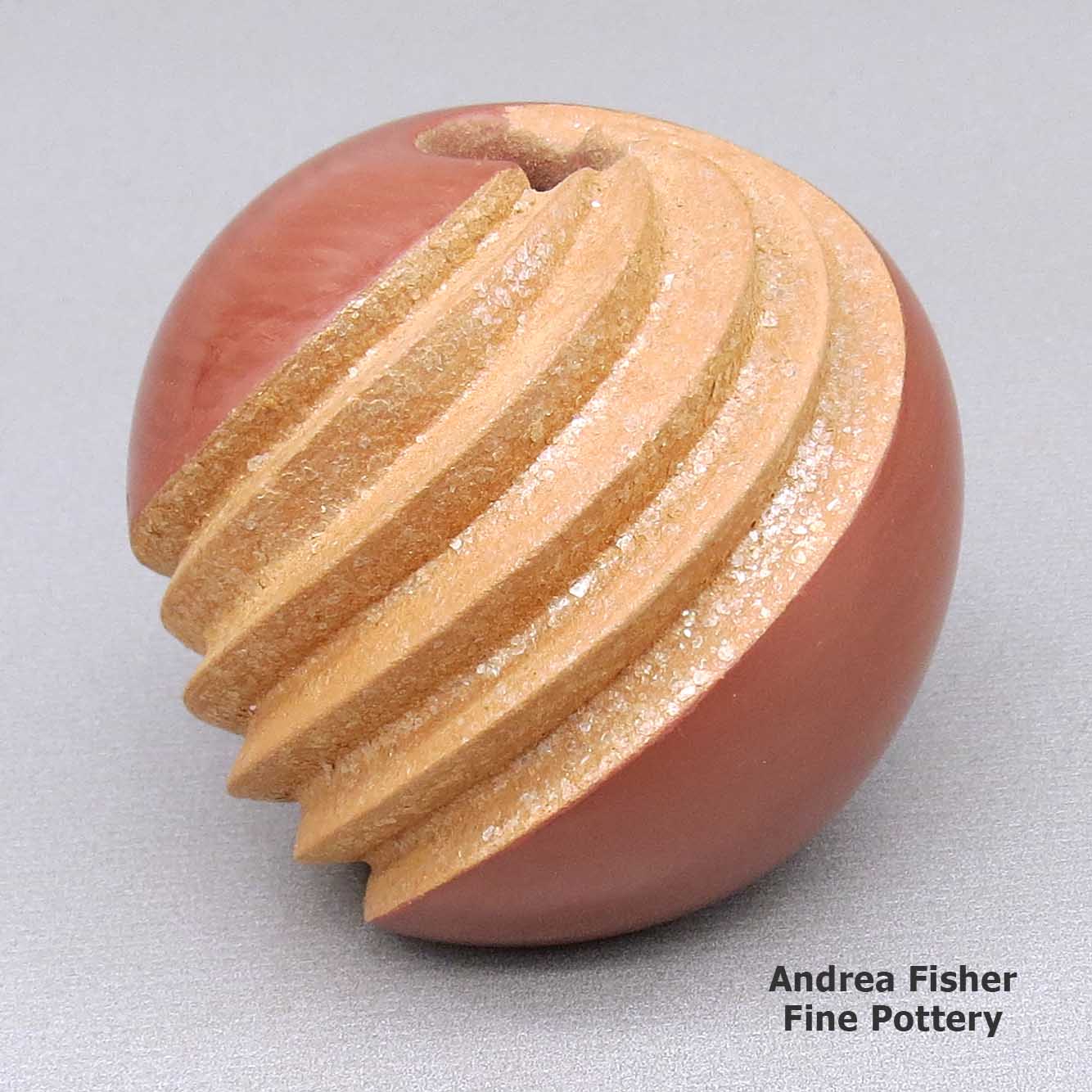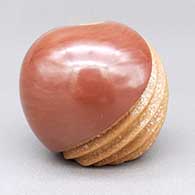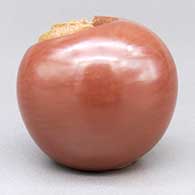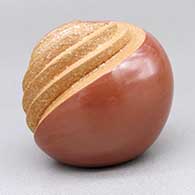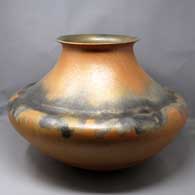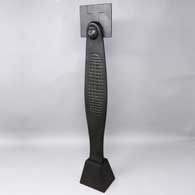
Dominique Toya
Jemez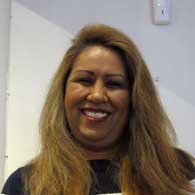
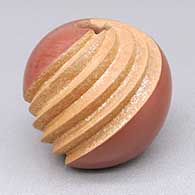
Dominique Toya was born to Maxine Toya and Clarence Toya in 1971 at Jemez Pueblo. In those days she was known as Damian and she began creating pottery at about the age of five. She credited her mother, Maxine, with being the inspiration behind her interest in learning the traditional art. Her aunt, Laura Gachupin, and grandmother, Marie G. Romero, completed the roster of influential family potters in her early life.
Dominique said she was inspired to create her signature swirl melon pots by well-known Santa Clara potter Nancy Youngblood. She was aiming for nothing short of perfection, from the shape of her pots to the swirls that pour out of her openings. "The smaller the opening," she said, "the swirlier they get." The lines that circle a Dominique pot are perfectly spaced by taking an ice pick and scratching through the clay one line at a time, eventually covering the pot from top to bottom. "It's all done by eyeball," she said. "It's just a part of me." Later she would sandpaper the grooves deep into the pot. Those deep groves are another signature, as is the sparkle in the final micaceous slip. She signed her pots as: "Dominique Toya, Jemez", followed by the corn symbol to denote her clan origin.
Her career shifted into high gear with an award in the pottery division at the 2000 Annual Heard Museum Guild Indian Arts Fair & Market. Then she was awarded Best of Class for Pottery at the 2009 Santa Fe Indian Market. Then collaboration between Dominique and Jody Naranjo of Santa Clara Pueblo earned the duo the Best of Show award at the 2010 Eiteljorg Museum of the American Indian in Indianapolis. Career success, she believed, was rooted in her decision to become "Dominique" and to leave behind an outer self that didn't fit her. Born "Damian", Dominique was already a successful potter before she accepted herself as a woman. She underwent hormone therapy for several years as she completed her transformation. "My personal changes, my hormone therapy: everything happened all at once," she said.
Dominique told us she still got her inspiration from her mother, her grandmother and from good friends Nancy Youngblood and Jody Naranjo. Her favorite shape to work with was the water jar, preferably carved with deep swirls and slipped with micaceous clay. As a 5th generation Jemez Pueblo potter she said clay was her life and it allowed her to relax and enjoy an amazing and fulfilling journey through life.
In August 2023, Dominique was awarded the Raw Materials Award at the Santa Fe Indian Market. Sadly, she passed on in mid-December, 2023.
Some Awards Dominique Earned
- 2023 Santa Fe Indian Market, Special Raw Material Award
- 2023 Santa Fe Indian Market, Classification IIA, Category 504 - Pins and Pendants, Second Place and an Honorable Mention
- 2019 Santa Fe Indian Market, Classification II - Pottery, Division A - Traditional unpainted pottery, Category 504 - Melon Bowls and Melon Jars, formed or carved: Honorable Mention
- 2019 Heard Museum Guild Indian Fair & Market, Classification II - Pottery, Division A - Painted, native clay, hand build, fired out-of-doors: First Place. Awarded for collaborative artwork with Maxine Toya. Awarded for artwork: Traditional Storage Jar
- 2019 Heard Museum Guild Indian Fair & Market, Classification II - Pottery, Division B - Unpainted, including ribbed, native clay, hand build, fired out-of-doors: Second Place. Awarded for artwork: Swirled Mica Water Jar
- 2019 Santa Fe Indian Market, Classification II - Pottery, Division B - Traditional Painted Pottery. Category 604 - Painted polychrome pottery in the style of Jemez, Zia, Santa Ana, Sandia, San Felipe, Isleta, any form: Second Place shared with Maxine Toya
- 2019 Santa Fe Indian Market, Classification II - Pottery, Division C - Traditional burnished black or red ware, incised, painted or carved, Category 704 - Incised or carved, any form: Second Place
- 2018 Santa Fe Indian Market, Classification II - Pottery, Division A - Traditional Unpainted Pottery, Category 504 - Melon Bowls and Melon Jars, Formed or Carved: Second Place
- 2018 Santa Fe Indian Market, Classification II - Pottery, Division B - Traditional Painted Pottery, Category 604 - Painted polychrome pottery in the style of Jemez, Zia, Santa Ana, Sandia, San Felipe, Isleta, any form: First Place. Shared First Place with Maxine Toya
- 2017 Santa Fe Indian Market: Classification II - Pottery, Division A - Traditional Unpainted Pottery, Category 504 - Melon bowls and melon jars, formed or carved: Honorable Mention
- 2016 Heard Museum Guild Indian Fair & Market, Classification II - Pottery, Division B - Traditional, Native Clay, Hand Built, Unpainted Including Ribbed: First Place
- 2015 Heard Museum Guild Indian Fair & Market. Judge's Choice Award - - Della C. Warrior. Awarded for artwork: Storage Jar
- 2015 Heard Museum Guild Indian Fair & Market. Judge's Choice Award - Kathleen L. Howard. Awarded for artwork: Storage Jar
- 2013 Heard Museum Guild Indian Fair & Market, Classification II - Pottery, Division B - Traditional, native clay, hand built, painted including ribbed: Honorable Mention
- 2012 Heard Museum Guild Indian Fair & Market, Classification II - Pottery, Division A - Traditional, native clay, hand built, painted: Honorable Mention shared with Maxine Toya
- 2012 Heard Museum Guild Indian Fair & Market, Classification II - Pottery, Division C - Traditional, native clay, hand built, carved: Honorable Mention
- 2010 Eiteljorg Museum Indian Market: Best of Show, collaborative work with Jody Naranjo. Awarded for artwork: "Double Insanity"
- 2010 Eiteljorg Museum Indian Market, Division 5 - Pottery, Category 501 - Traditional: First Place. Awarded for artwork: Swirled Vase
- 2010 Eiteljorg Museum Indian Market, Division 5 - Pottery, Category 502 - Contemporary: First Place for collaborative work with Jody Naranjo. Awarded for artwork: "Double Insanity"
- 2010 Eiteljorg Museum Indian Market, Division 5 - Pottery, Category 504 - Miscellaneous: First Place. Awarded for artwork: "Pride"
- 2010 Heard Museum Guild Indian Fair & Market, Classification II - Pottery, Division B - Traditional, native clay, hand built, unpainted, including ribbed: Second Place
- 2010 Heard Museum Guild Indian Fair & Market: Judge's Choice Award - Helen Kersting. Shared with Jody Naranjo. Awarded for artwork: "Double Insanity"
- 2008 Heard Museum Guild Indian Fair & Market. Classification II - Pottery: Best of Class
- 2008 Heard Museum Guild Indian Fair & Market. Classification II - Pottery, Division B - Traditional, native clay, hand built, unpainted: First Place
100 West San Francisco Street, Santa Fe, New Mexico 87501
(505) 986-1234 - www.andreafisherpottery.com - All Rights Reserved

Jemez Pueblo

Ruins of San Jose de las Jemez Mission
As the drought in the Four Corners region deepened in the late 1200's, several clans of Towa-speaking people migrated southeastward to the Canyon de San Diego area in the southern Jemez mountains. Other clans of Towa-speaking people migrated southwest and settled in the Jeddito Wash area in northeastern Arizona, below Antelope Mesa and southeast of Hopi First Mesa. The migrations began around 1275 and were mostly complete by 1350.
Archaeologist Jesse Walter Fewkes argues that pot shards found in the vicinity of the ruin at Sikyátki (near the foot of Hopi First Mesa) speak to the strong influence of earlier Towa-speaking potters on what became "Sikyátki Polychrome" pottery (Sikyátki was a village at the foot of First Mesa, destroyed before the first Hopi contact with the Spanish in 1540). Fewkes maintained that Sikyátki Polychrome pottery is the finest ceramic ware ever made in prehistoric North America.
Francisco de Coronado and his men arrived in the Jemez Mountains of Nuevo Mexico in 1539. By then the Jemez people had built several large masonry villages among the canyons and on some high ridges in the area. Their population was estimated at about 30,000 and they were among the largest and most powerful tribes in Northern New Mexico. Some of their pueblos reached five stories high and contained as many as 3,000 rooms.
Because of the nature of the landscape they inhabited, farming was very hard. So the Jemez became traders, too, and their people traded goods all over the Southwest and northern Mexico.
The arrival of the Spanish was disastrous for the Jemez and they resisted the Spanish with all their might. That led to many atrocities against the tribe until they rose up in the Pueblo Revolt of 1680 and evicted the Spanish from northern New Mexico. With the Spanish gone, the Jemez destroyed much of what they had built on Jemez land. Then they concentrated on preparing themselves for the eventual return of the hated priests and the Spanish military.
The Spanish returned in 1692 and their efforts to retake northern New Mexico bogged down as the Jemez fought them doggedly for four years. In 1696 many Jemez came together, killed a Franciscan missionary and then fled to join their distant relatives in the Jeddito Wash area. They remained at Jeddito Wash for several years before returning to the Jemez Mountains. As a result of that long ago contact, there are still strong ties between the Jemez and their cousins on Navajo territory at Jeddito. On their return to the Jemez Mountains, the people built the pueblo they now live in (Walatowa: The Place) and made peace with the Spanish government.
Some of the Jemez people had been making a type of plainware pottery (simple, undecorated, utilitarian) when they were still in the Four Corners area, while others had developed a distinctive type of black-on-white pottery. In moving to the Jemez Mountains, they brought their knowledge and techniques with them but had to adapt to the different materials available to work with. Over time, the Jemez got better in their agricultural practices and began trading agricultural goods to the people of Zia Pueblo in return for pottery. By the mid-1700's, the Jemez were producing almost no pottery.
East of what is now Santa Fe is where the ruins of Pecos Pueblo are found. Pecos Pueblo was a large pueblo housing up to 2,000 people at its height. The people of Pecos and the Galisteo Basin were the only other speakers of the Towa language in New Mexico and when that area fell on increasingly hard times (Apache and Comanche raids, European diseases, drought), Pecos was finally abandoned in 1838 when the last 17 residents moved to Jemez. The Governor of Jemez welcomed them and allowed them to retain many of their Pecos tribal offices (governorship and all). Members of former Pecos families still return to the site of Pecos Pueblo every year to perform religious ceremonies in honor of their ancestors.
When general American interest in Puebloan pottery started to take off in the 1960's, the people of Jemez sought to recover that lost heritage. Today, the practice of traditional pottery-making is very much alive and well among the Jemez.
The focus of Jemez pottery today has turned to the making of storytellers, an art form that now accounts for more than half of their pottery production. Storytellers are usually grandparent figures with the figures of children attached to their bodies. The grandparents are pictured orally passing tribal songs and histories to their descendants. While this visual representation was first created at Cochiti Pueblo (a site in close geographical proximity to Jemez Pueblo) in the early 1960's by Helen Cordero, it speaks to the relationship between grandparents and grandchildren of every culture.
The pottery vessels made at Jemez Pueblo today are no longer black-on-white. Instead, the potters have adopted many colors, styles and techniques from other pueblos to the point where Jemez potters no longer have one distinct style of their own beyond that which stems naturally from the materials they themselves acquire from their surroundings: it doesn't matter what the shape or design is, the clay says uniquely "Jemez."
100 West San Francisco Street, Santa Fe, New Mexico 87501
(505) 986-1234 - www.andreafisherpottery.com - All Rights Reserved

Jemez
$ 525
dkje3f129
Small red and micaceous gold jar with a spiral melon design
2.25 in L by 2.25 in W by 2.25 in H
Condition: Very good, normal wear
Signature: Dominique Toya, with cornstalk hallmark
100 West San Francisco Street, Santa Fe, New Mexico 87501
(505) 986-1234 - www.andreafisherpottery.com - All Rights Reserved

Micaceous Clay Pottery

Angie Yazzie
Taos
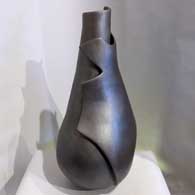
Christine McHorse
Navajo
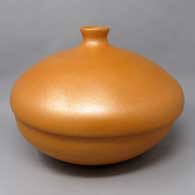
Clarence Cruz
San Juan/Ohkay Owingeh
Micaceous clay pots are the only truly functional Pueblo pottery still being made. Some special micaceous pots can be used directly on the stove or in the oven for cooking. Some are also excellent for food storage. Some people say the best beans and chili they ever tasted were cooked in a micaceous bean pot. Whether you use them for cooking or storage or as additions to your collection of fine art, micaceous clay pots are a beautiful result of centuries of Pueblo pottery making.
Between Taos and Picuris Pueblos is US Hill. Somewhere on US Hill is a mica mine that has been in use for centuries. Excavations of ancient ruins and historic homesteads across the Southwest have found utensils and cooking pots that were made of this clay hundreds of years ago.
Not long ago, though, the making of micaceous pottery was a dying art. There were a couple potters at Taos and at Picuris still making utilitarian pieces but that was it. Then Lonnie Vigil felt the call, returned to Nambe Pueblo from Washington DC and learned to make the pottery he became famous for. His success brought others into the micaceous art marketplace.
Micaceous pots have a beautiful shimmer that comes from the high mica content in the clay. Mica is a composite mineral of aluminum and/or magnesium and various silicates. The Pueblos were using large sheets of translucent mica to make windows prior to the Spaniards arriving. It was the Spanish who brought a technique for making glass. There are eight mica mining areas in northern New Mexico with 54 mines spread among them. Most micaceous clay used in the making of modern Pueblo pottery comes from several different mines near Taos Pueblo.
As we understand it, potters Robert Vigil and Clarence Cruz have said there are two basic kinds of micaceous clay that most potters use. The first kind is extremely micaceous with mica in thick sheets. While the clay and the mica it contains can be broken down to make pottery, that same clay has to be used to form the entire final product. It can be coiled and scraped but that final product will always be thicker, heavier and rougher on the surface. This is the preferred micaceous clay for making utilitarian pottery and utensils. It is essentially waterproof and conducts heat evenly.
The second kind is the preferred micaceous clay for most non-functional fine art pieces. It has less of a mica content with smaller embedded pieces of mica. It is more easily broken down by the potters and more easily made into a slip to cover a base made of other clay. Even as a slip, the mica serves to bond and strengthen everything it touches. The finished product can be thinner and have a smoother surface. As a slip, it can also be used to paint over other colors of clay for added effect. However, these micaceous pots may be a bit more water resistant than other Pueblo pottery but they are not utilitarian and will not survive utilitarian use.
While all micaceous clay from the area of Taos turns golden when fired, it can also be turned black by firing in an oxygen reduction atmosphere. Black fire clouds are also a common element on golden micaceous pottery.
Mica is a relatively common component of clay, it's just not as visible in most. Potters at Hopi, Zuni and Acoma have produced mica-flecked pottery in other colors using finely powdered mica flakes. Some potters at San Ildefonso, Santa Clara, Jemez and San Juan use micaceous slips to add sparkle to their pieces.
Potters from the Jicarilla Apache Nation collect their micaceous clay closer to home in the Jemez Mountains. The makeup of that clay is different and it fires to a less golden/orange color than does Taos clay. Some clay from the Picuris area fires less golden/orange, too. Christine McHorse, a Navajo potter who married into Taos Pueblo, uses various micaceous clays on her pieces depending on what the clay asks of her in the flow of her creating.
There is nothing in the makeup of a micaceous pot that would hinder a good sgraffito artist or light carver from doing her or his thing. There are some who have learned to successfully paint on a micaceous surface. The undecorated sparkly surface in concert with the beauty of simple shapes is a real testament to the artistry of the micaceous potter.
100 West San Francisco Street, Santa Fe, New Mexico 87501
(505) 986-1234 - www.andreafisherpottery.com - All Rights Reserved

Benigna Medina Madelena Family Tree - Jemez Pueblo
Disclaimer: This "family tree" is a best effort on our part to determine who the potters are in this family and arrange them in a generational order. The general information available is questionable so we have tried to show each of these diagrams to living members of each family to get their input and approval, too. This diagram is subject to change should we get better info.
- Benigna Medina Madelena (c.1880-) & Ramon Madelena
- Persingula M. Gachupin (ca. 1910-1994) & Joe R. Gachupin
- Marie G. Romero (1927-)
- Laura Gachupin (1954-)
- Benina Foley (1982-)
- Gordon Foley (1975-)
- Maxine Toya (1948-)
- Dominique Toya (1971-)
- Mariam Toya (1974-)
- Laura Gachupin (1954-)
- Leonora G. Fragua (1938-)
- Matthew Fragua (1963-)
- Virginia Ponca Fragua (1961-) & M. Pecos
- Brandon Pecos Fragua (1993-)
- Bertha Gachupin (1954-)
- Antonia Gachupin (1970s-) & Albert Yepa
- Kajzia Gachupin (1991-)
- Kiana Gachupin (1993-)
- Okoya Gachupin
- Antonia Gachupin (1970s-) & Albert Yepa
- Marie G. Romero (1927-)
- Elcira Madelena (c.1915-)
- Mary Rose Toya
- Josephita Madelena
Some of the above info is drawn from Southern Pueblo Pottery, 2000 Artist Biographies, by Gregory Schaaf, © 2002, Center for Indigenous Arts & Studies. Other info is derived from personal contacts with family members and through interminable searches of the Internet and cross-examination of the data found.
(505) 986-1234 - www.andreafisherpottery.com - All Rights Reserved
